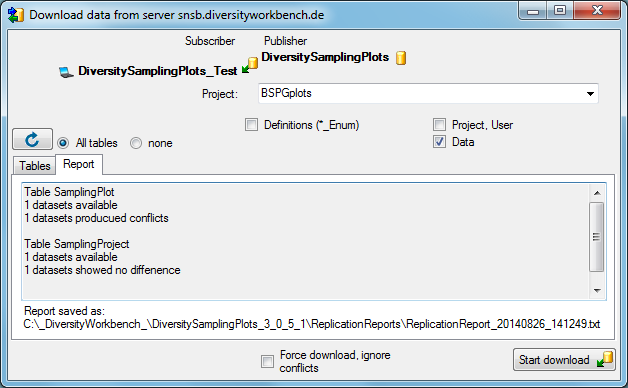

If you wish to work with your data on a local database (called subscriber), e.g. on your laptop, and this data should be synchronized with a database on a central server (called publisher), you may use the replication function of DiversitySamplingPlots. To install the database on your local computer see the database installation section.
To use the replication function you must be assigned to the roles
 Replicator or Administrator.
Replicator or Administrator.
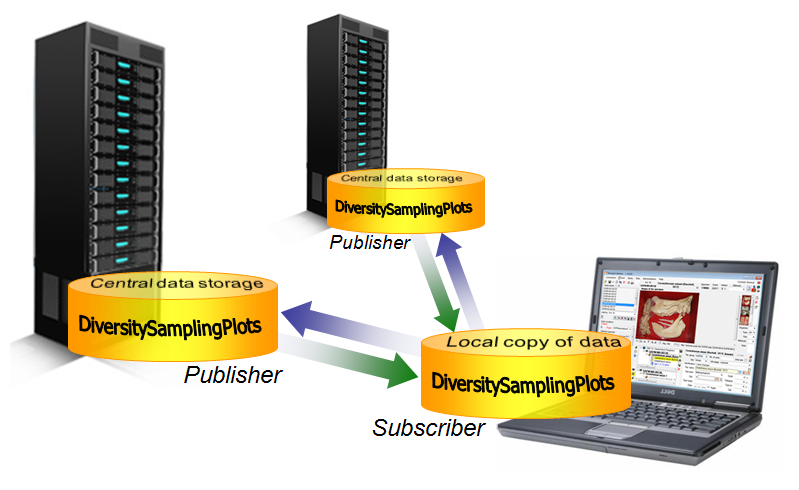

To define a publishing database, choose Data ->  Replication ->
Replication ->  Add Publisher from the menu.
A window will open where you can choose the publisher. When the publisher is
set, you may transfer data between your local database (subscriber) and the
publisher. This function is only available for administrators.
Add Publisher from the menu.
A window will open where you can choose the publisher. When the publisher is
set, you may transfer data between your local database (subscriber) and the
publisher. This function is only available for administrators.
To remove a publisher from the list, choose Data ->  Replication ->
Replication ->  [Publisher] ->
[Publisher] -> ![]() Remove
from the menu (where [Publisher] is the name of the publishing database on the
publishing server). This function is only available for administrators.
Remove
from the menu (where [Publisher] is the name of the publishing database on the
publishing server). This function is only available for administrators.

Initially you may want to remove all previous data from your local database
(subscriber). Choose
Data ->  Replication ->
Replication ->
 Clean database ...
from the menu. A window will open where you may choose the ranges
which should be cleared:
Clean database ...
from the menu. A window will open where you may choose the ranges
which should be cleared:
Choose the data ranges you wish to clear and click on the
 button. All tables which contain data will be listed as shown below.
button. All tables which contain data will be listed as shown below.
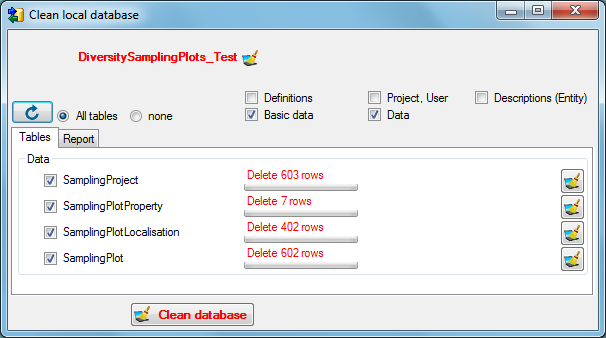
Choose the tables which should be cleared and click on the Clean database button. Please keep in mind that you can not delete data from a table as long as there is data in a related table depending on the data you wish to delete. The sequence of the tables is organized to avoid these problems.

To download data from the publisher choose Data ->
 Replication ->
Replication ->
 [Publisher] ->
[Publisher] ->
 Download
from the menu (where [Publisher] is the name of the publishing database on the
publishing server). A form will open as shown below. Choose the project of the data
and the data ranges (see above) which you wish to download. Click on the
Download
from the menu (where [Publisher] is the name of the publishing database on the
publishing server). A form will open as shown below. Choose the project of the data
and the data ranges (see above) which you wish to download. Click on the
 button to list the tables
containing data. To start the download click on the Start download
button to list the tables
containing data. To start the download click on the Start download
 button. With the Force download, ignore conflicts option you can decide whether or
not the data in your local database (subscriber) should be checked for changes
before you download the data from the publisher.
button. With the Force download, ignore conflicts option you can decide whether or
not the data in your local database (subscriber) should be checked for changes
before you download the data from the publisher.
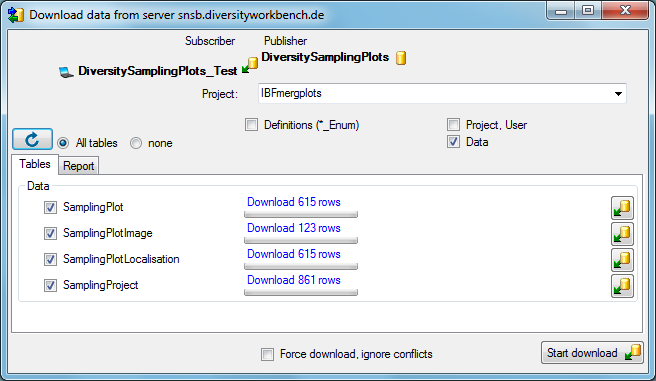
If the selected project does not exist in the Subscriber database, you will be prompted to create it automatically.
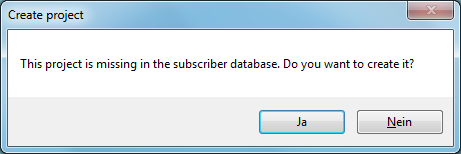

To merge data from your local subscriber database with the
publisher, you must first select a project in the Query section of
the SamplingPlots main window. Then choose
Data ->  Replication ->
Replication ->  [Publisher] ->
[Publisher] ->  Merge
from the menu (where [Publisher] is the name of the publishing database
on the publishing server). According to the download, choose the data ranges
and click on the
Merge
from the menu (where [Publisher] is the name of the publishing database
on the publishing server). According to the download, choose the data ranges
and click on the  button. To start
the merging, click on the Start merge
button. To start
the merging, click on the Start merge  button.
button.

To transfer data from your local subscriber database to the
publisher, you must first select a project in the Query section of
the SamplingPlots main window. Then choose
Data ->  Replication ->
Replication ->  [Publisher] ->
[Publisher] ->  Upload
from the menu (where [Publisher] is the name of the publishing database
on the publishing server). According to the download, choose the data ranges
and click on the
Upload
from the menu (where [Publisher] is the name of the publishing database
on the publishing server). According to the download, choose the data ranges
and click on the  button. To start
the upload, click on the Start upload
button. To start
the upload, click on the Start upload  button. With the Force upload, ignore conflicts option you can decide whether or not
the data on the server (Publisher) should be checked for changes before you upload
the data from your local database (Subscriber).
button. With the Force upload, ignore conflicts option you can decide whether or not
the data on the server (Publisher) should be checked for changes before you upload
the data from your local database (Subscriber).

If the data transfer was successfull, the numbers of the transfered data will be shown as below.
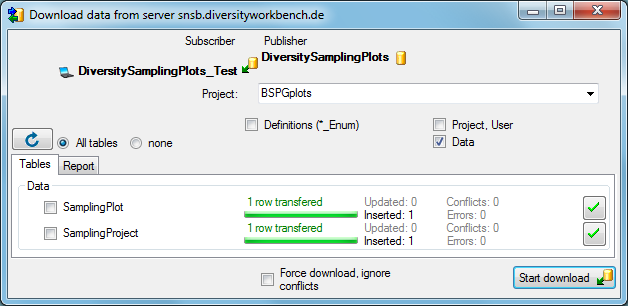
During the download or upload a conflict may occur, if the data has been edited in both databases. This will be indicated as follows.

Click on the  button to open a
window where you can choose between the two versions of the data
as found in the publisher and the subscriber database.
button to open a
window where you can choose between the two versions of the data
as found in the publisher and the subscriber database.

The conflicting columns are marked red. For text values the program will
create a combination of both values (see above) for a merged version of
the data. Choose the prefered version and click Solve conflict
 button. If you can not
solve a conflict, use the
Stop conflict resolution
button. If you can not
solve a conflict, use the
Stop conflict resolution
 button respectively.
button respectively.
At the end of each transfer a report will be created with a summary for every table which has been included.
